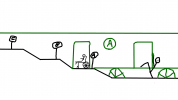I'm not sure how many people wouldn't find that difficult to get at.
That seems like it needs both Harrington Humps AND platform-mounted movable sections...
Or a completely new platform surface.
Even the staff member is looking dubious about leaving the train
That seems like it needs both Harrington Humps AND platform-mounted movable sections...
Or a completely new platform surface.
Even the staff member is looking dubious about leaving the train


